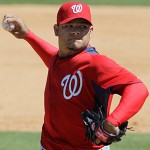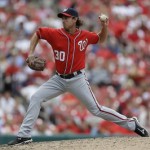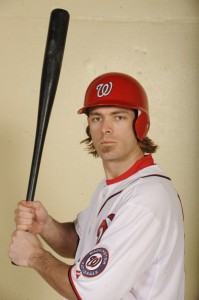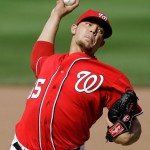
Rodriguez getting ready to fire in another pitch he has no idea where its going. Photo via humorfeast.blogspot.com
Holiday edition mailbag from MLB.com’s Nats beat writer Bill Ladson for 12/28/12.
As always, I write my response here before reading his, and sometimes edit questions for clarity.
Q: Where does Henry Rodriguez fit in the Nationals’ plan this upcoming season?
A: A good question; Mike Rizzo loves Rodriguez but I find him completely frustrating as a fan. In 2011 he led the league in wild pitches despite only throwing 65 innings, and in 2012 he had a -0.7 WAR and a 69 ERA+ before hitting the DL for season ending surgery. He’s got no minor league options and thus has to be either carried on the active roster or be subject to DL shenanigans. Davey Johnson also loves him, and said he was the Nats best pitcher last spring training. My guess is that Rodriguez holds it together for another spring, breaks camp with the team and then plays his way into a DFA. The team can replace his 7th/8th inning innings with Christian Garcia rather easily (assuming of course that the team realizes that Garcia’s arm is too fragile to reliably be depended upon as a starter). Ladson predicts he’ll be a middle reliever for this team in 2013.
Q: What are the Nats going to do with first baseman Chris Marrero?
A: Great question; he has one more minor league option, is clearly behind the likes of Chad Tracy and Tyler Moore on the first base backup pecking order, but really hasn’t got much left to prove in the minors. He hit admirably enough at AA and AAA in 2010 and 2011. I think Marrero’s problem is that he’s stuck at first base but has limited power capabilities. If he played LF, perhaps you could deal with someone who didn’t look to hit more than a handful of homers at the MLB level. But he plays a position that needs 25-30 homers of production. I think he’s trade bait ultimately. Ladson says the team’s bench is set and that Marrero may be traded.
Q: Isn’t it time to make Ross Detwiler the No. 4 starter? Also, what do you think of Nats’ rotation?
A: I’m not exactly sure what the questioner wants; does it really matter if Detwiler is #4 or #5? Not really (not until the playoffs anyway). Detwiler is the 5th starter inarguably on this team, looking at the accomplishments of the 4 other guys.
I think the rotation is either the best or competing to be the best in the sport. I’ve got a future post ranking all 30 rotations (I’m more or less waiting for the last of the impact free agents to sign before publishing it), and (teaser) the Nats are in the top 3 without question. However, the Nats rotation is very, very thin. If one of the 5 guys goes down, I really don’t know who is going to step up to make starts. Zach Duke? Ryan Perry? Lets pray for a healthy spring training. Ladson says Detwiler is the 4th starter entering spring training, and that he likes the rotation. Not a very deep answer.
Q: Bill Bray was an OK pitcher in his last stint with the Nationals. Do you think he will be anywhere near as good the second time around?
A: It all depends on his health. A groin strain and then a back strain cost him more than 100 games last year. Those injuries should be healed up well enough by now; if he was recovering from an arm injury I’d be more worried. He posted a 133 ERA+ in 2011; i don’t see any reason why he couldn’t repeat that performance in 2013. However, I still think the team needs to pursue one more lefty out of the pen. Michael Gonzalez just signed with Milwaukee, meaning that all three of our lefty bullpen guys from 2012 are gone. J.P. Howell remains available but competition is fierce for his services. Ladson says it all depends on his health.
Q: Should the Nationals be concerned with the way Ryan Zimmerman was releasing the ball at the end of 2012 season?
A: Yes. They should be concerned with the way he’s been throwing the ball for several years now, AND they should have been concerned with the effects of the shoulder injury that was bothering him all season. Off-season surgery fixed the latter part. As for the former … I think its just inevitable that Zimmerman moves to 1B. At some point I feel his arm action is going to turn into some sort of Chuck Knoblock mental block. Ladson reminds of Zimmerman’s surgery.
Q: Why don’t the Nationals just give Adam LaRoche a third year? If things don’t pan out by the third year, the team could trade him.
A: Good question. The core of the team is locked up for 3 more years, why not extend the offer? I think perhaps the answer relates to the massive amount of arbitration salary the team is looking at by 2015. They might have 12-13 arbitration cases with escalating salary by then. And its no guarantee to be able to trade Adam LaRoche in 2015; what kind of return would we get? We’d likely get marginal prospects AND have to pay most of his salary. I’m not even mentioning the obvious; he just turned 33; do you want to guarantee a 3rd year 8-figure salary to a 35-yr old? Isn’t that exactly the kind of contracts that are killing the Phillies right now? Plus, signing LaRoche locks of 1B for 3 years … meaning no room for Moore for 2 more years AND no room to move Zimmerman if his arm turns into mush. I know the team likes LaRoche, but it makes more sense for the future of the team to let him walk. Ladson echos my comments on age and having to eat money on a trade. He also mentions that the team would like Matthew Skole at first by 2015, which I don’t necessarily think will happen (but we’ll see).







